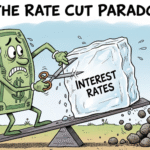Your investment landscape shifted overnight as banking concerns rippled through global markets, creating both risks and opportunities you need to understand right now.
The Banking Issue You Can’t Ignore
Two significant developments are shaking investor confidence in the U.S. regional banking sector. One major lender disclosed a $50 million loss on California loans, while another initiated a major fraud lawsuit. While these issues appear contained, you should recognize the warning signs—similar stress points triggered the 2023 banking crisis, and the conditions that created that tinderbox haven’t fully resolved.
This matters to your portfolio because banking stress has a cascading effect. U.S. banking stocks plummeted, dragging major indices lower and triggering a flight to safety that’s reshaping asset prices across every market you trade.
Where Smart Money Is Moving—And Where Yours Should Be
Gold has claimed a new record at $4,378 per ounce, marking a remarkable 7.6% weekly gain—its strongest performance since early 2020. If you’ve been waiting for confirmation that safe-haven assets are back in favor, this is it. Silver has also reached new peaks, offering you a secondary precious metals opportunity.
Treasury yields are telling you something critical: Two-year yields hit a fresh three-year low of 3.40%, while ten-year yields dropped to 3.959%. This signals that markets are pricing in at least two more quarter-point Federal Reserve rate cuts this year. For your bond positions, this represents your third consecutive week of gains.
Currency Moves Creating Your Next Trade Setup
The U.S. dollar is heading for a 0.6% weekly loss, hitting its lowest level in ten days. This weakness is your opportunity if you’re positioned correctly:
- The Japanese yen has strengthened 0.7% for the week
- The Swiss franc gained 0.9%, reflecting its traditional safe-haven appeal
These currency shifts affect your international investments and create potential forex trading opportunities as fear drives capital flows.
Equity Markets: Understanding Your Risk
Asian markets are confirming the negative sentiment you’re seeing globally:
- Japan’s Nikkei fell 1%, with banking stocks leading the decline
- MSCI Asia-Pacific index dropped 0.9%, pushing the week into negative territory
- Chinese and Hong Kong markets tumbled 1.4%
Even strong corporate earnings couldn’t overcome the fear. Taiwan’s chipmaking giant posted record quarterly profit with optimistic AI spending forecasts, yet shares still fell 0.9%. This disconnect between fundamentals and price action tells you that fear is currently stronger than earnings—a critical insight for timing your entries and exits.
U.S. futures signal more pain ahead, with S&P 500 and Nasdaq futures down 0.3%, while European markets face steeper 0.7-0.9% declines.
The Geopolitical Wildcard Affecting Your Energy Holdings
Oil prices have hit new five-month lows as diplomatic developments create uncertainty. U.S. crude fell to $57.04 per barrel, while Brent dropped to $60.63. Announced plans for a U.S.-Russia summit to discuss ending the Ukraine conflict are driving this decline.
For your energy sector positions, this represents both a threat to current holdings and a potential buying opportunity if you believe geopolitical tensions will resurface.
Trade Tensions Adding Pressure to Your China Exposure
Rising U.S.-China trade tensions over rare earth controls are adding another layer of risk to your Asian equity exposure. China has rejected calls to roll back export curbs, escalating economic friction that could impact supply chains and corporate profitability across sectors you hold.
Your Action Plan for This Environment
This market environment demands strategic positioning:
- Reassess your banking sector exposure given the emerging stress signals
- Consider increasing safe-haven allocations in gold, silver, and quality bonds
- Evaluate your currency hedges as dollar weakness continues
- Monitor your energy positions for both downside protection and contrarian opportunities
- Prepare for continued volatility with clear stop-losses and position sizing
The confluence of banking fears, rate cut expectations, and geopolitical uncertainty creates a complex landscape. Your success depends on recognizing that when fear dominates markets, the relationship between fundamentals and price action breaks down—creating both dangers for the unprepared and opportunities for those positioned correctly.













